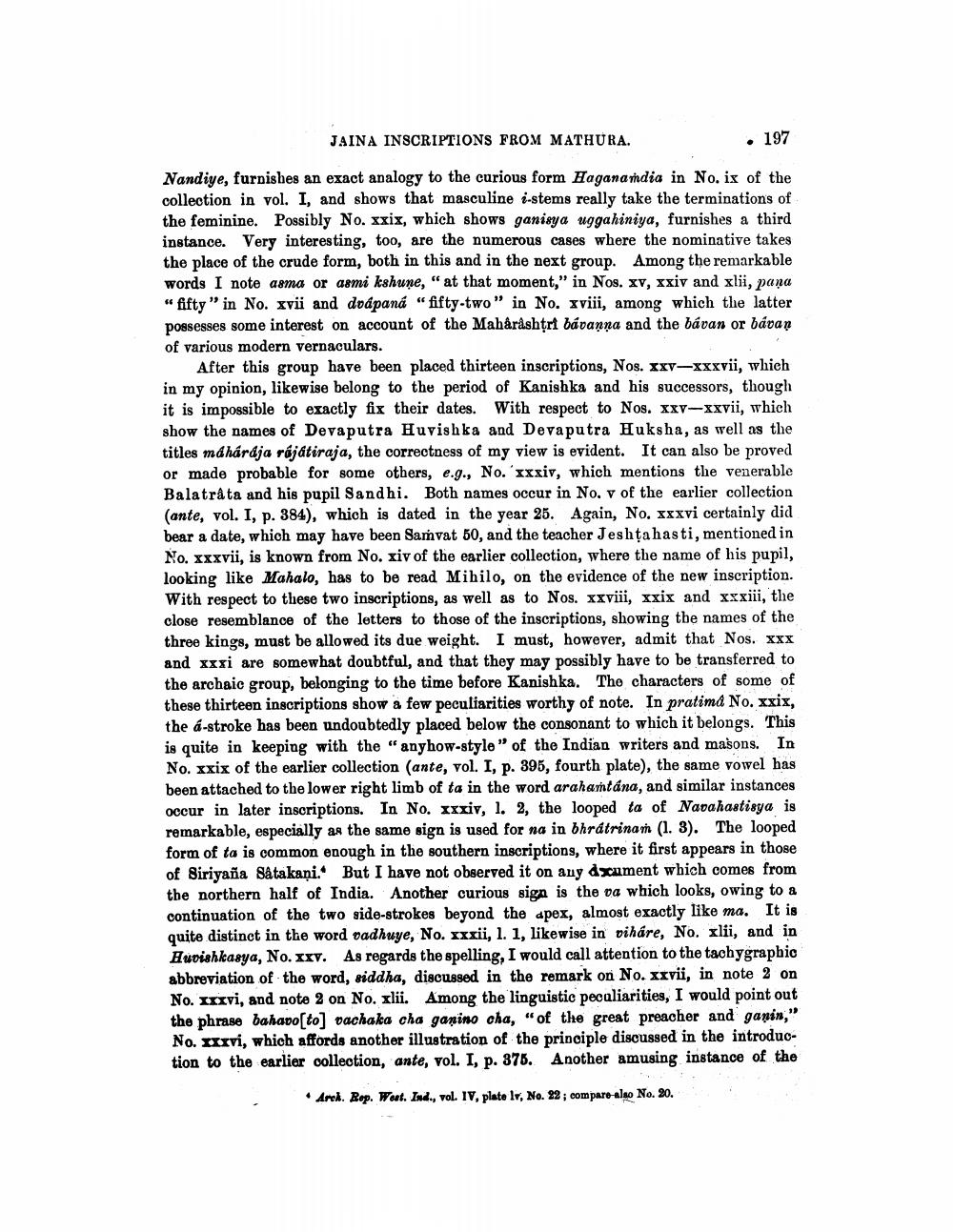________________
JAINA INSCRIPTIONS FROM MATHURA.
. 197
Nandiye, furnishes an exact analogy to the curious form Haganandia in No. ix of the collection in vol. I, and shows that masculine e-stems really take the terminations of the feminine. Possibly No. xxix, which shows ganisya uggahiniya, furnishes a third instance. Very interesting, too, are the numerous cases where the nominative takes the place of the crude form, both in this and in the next group. Among the remarkable words I note asma or asmi kshune," at that moment," in Nos. xv, xxiv and xlii, pana " fifty" in No. xvii and drápaná "fifty-two" in No. xviii, among which the latter possesses some interest on account of the Maharashtrt bávanna and the bávan or bávan of various modern vernaculars.
After this group have been placed thirteen inscriptions, Nos. XXV-xxxvii, which in my opinion, likewise belong to the period of Kanishka and his successors, though it is impossible to exactly fix their dates. With respect to Nos. xxv-xxvii, which show the names of Devaputra Huvishka and Devaputra Huksha, as well as the titles máhárdja rájátiraja, the correctness of my view is evident. It can also be proved or made probable for some others, e.g., No. xxxiv, which mentions the venerable Balatråta and his pupil Sandhi. Both names occur in No. v of the earlier collection (ante, vol. I, p. 384), which is dated in the year 25. Again, No. xxxvi certainly did bear a date, which may have been Samvat 50, and the teacher Jeshtahasti, mentioned in No. xxxvii, is known from No. xiv of the earlier collection, where the name of his pupil, looking like Mahalo, has to be read Mihilo, on the evidence of the new inscription. With respect to these two inscriptions, as well as to Nos. xxviii, xxix and xxxiii, the close resemblance of the letters to those of the inscriptions, showing the names of the three kings, must be allowed its due weight. I must, however, admit that Nos. XXX and xxxi are somewhat doubtful, and that they may possibly have to be transferred to the archaic group, belonging to the time before Kanishka. The characters of some of these thirteen inscriptions show a few peculiarities worthy of note. In pratima No. xxix, the a-stroke has been undoubtedly placed below the consonant to which it belongs. This is quite in keeping with the "anyhow-style" of the Indian writers and masons. In No. xxix of the earlier collection (ante, vol. I, p. 395, fourth plate), the same vowel has been attached to the lower right limb of ta in the word arahantána, and similar instances occur in later inscriptions. In No. xxxiv, l. 2, the looped ta of Navahastisya is remarkable, especially as the same sign is used for na in bhrátrinam (1. 3). The looped form of ta is common enough in the southern inscriptions, where it first appears in those of Siriyaña Satakani.* But I have not observed it on any dxument which comes from the northern half of India. Another curious sign is the da which looks, owing to a continuation of the two side-strokes beyond the apex, almost exactly like ma. It is quite distinct in the word vadhuye, No. xxxii, 1. 1, likewise in viháre, No. xlii, and in Huvishkasya, No. xxv. As regards the spelling, I would call attention to the tachygraphic abbreviation of the word, siddha, discussed in the remark on No. xxvii, in note 2 on No. Xxxvi, and note 2 on No. xlii. Among the linguistic peculiarities, I would point out the phrase bahadosto] vachaka cha gañino cha, "of the great preacher and gamin," No. XXXVI, which affords another illustration of the principle discussed in the introduction to the earlier collection, ante, vol. I, p. 375. Another amusing instance of the
. Arch. Rep. Wart. Ind., vol. IV, plate I, No. 22; compare also No. 20.




